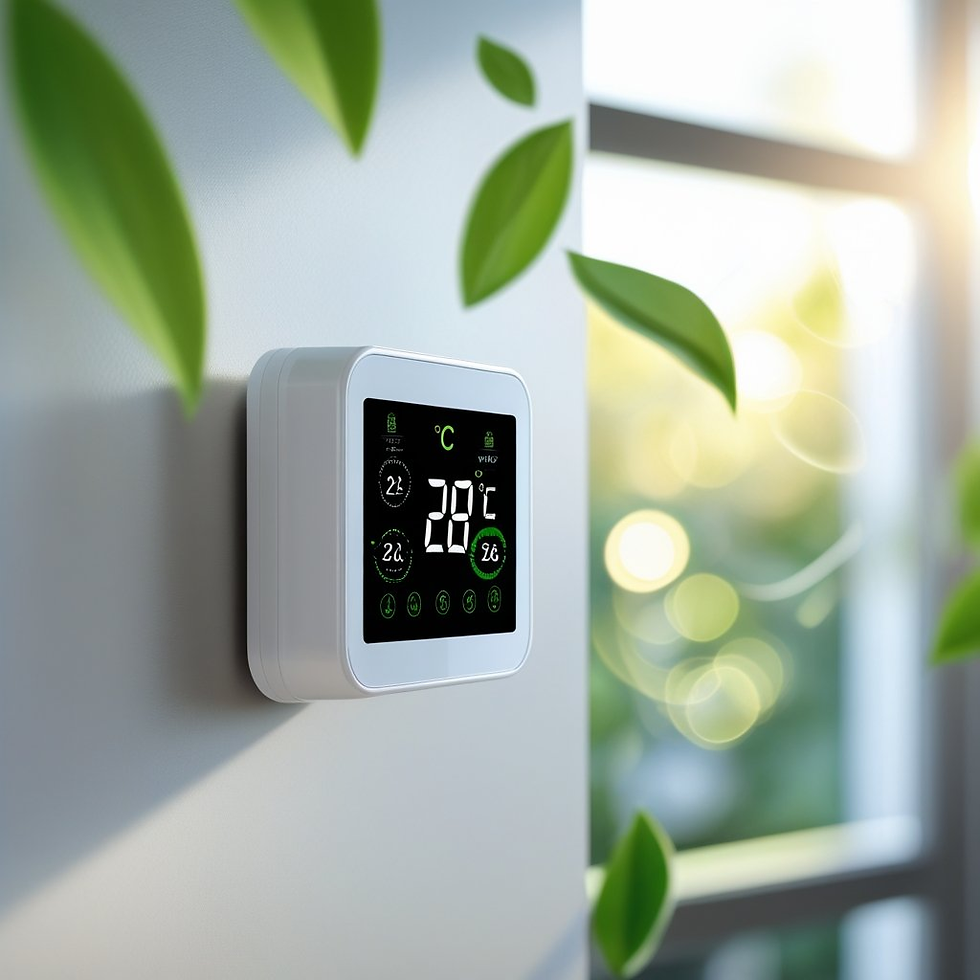Best AC Temperature Settings for Energy Saving (2025 Guide)
- Jayant Upadhyay
- Jul 25
- 4 min read

Table of Contents
Why AC Temperature Matters
Understanding Energy Usage and AC Behavior
Optimal Thermostat Range: 24°C–26°C
For Every Degree Lower: The Energy Cost
Smart Strategies: Away, Sleep, Zoning
Real Global Guidelines & Regulations
The Role of Inverter ACs & Fans
Regional Adaptations (Humid vs Arid Climates)
Long-term Energy, Cost & Health Impacts
Common Myths & Misconceptions
Smart Thermostats & AI for Efficiency
Maintenance & House Habits That Save Energy
FAQs
Conclusion
1. Why AC Temperature Matters
Setting your air conditioner to the correct temperature isn’t just about comfort—it has a direct impact on energy usage, AC lifespan, bills, and even health. Every degree you lower below the optimal range increases compressor runtime and power consumption.
2. Understanding Energy Usage and AC Behavior
AC units cool air through their compressors. Setting a low temperature like 18°C (64°F) doesn’t cool faster—it simply runs longer to maintain that level, raising electricity usage Reddit+13housegyan.com+13The Times of India+13Reddit+13circolife.com+13India Today+13HomebuildingMySmartPrice.comThe Times of India. Once the target temperature is reached, the compressor cycles off to maintain it, minimizing energy consumption The Times of IndiaCarrier.
3. Optimal Thermostat Range: 24°C–26°C
✅ Why This Range Works:
BEE and energy experts endorse 24–26 °C (~75–78 °F) as the sweet spot between cooling comfort and efficiency India TV Newshousegyan.comUP Excise Portal.
Keeping AC above 22 °C can yield up to 6% savings per °C on cooling costs REPSOL+15circolife.com+15India TV News+15.
Falling below 24 °C often leads to diminishing returns and discomfort, especially during seasons with large temperature differences between indoors and outdoors Down To EarthIndia Today.
National Energy Recommendations:
Bureau of Energy Efficiency (India): 24 °C default for energy savings.
Spain, China, South Korea: Legal limits prevent cooling below 26–27 °C in public buildings circolife.com+1India TV News+1Down To Earth.
4. For Every Degree Lower: The Energy Cost
Setting (°C) | Energy Use vs Baseline |
25°C | Baseline |
24°C | –6% |
23°C | –12% |
22°C | –18% |
21°C | –24% |
These figures highlight how just a few degrees can trigger large savings Wikipedia+15housegyan.com+15The Sun+15. In arid regions, users tolerate slightly warmer temps when paired with good airflow and fans Homebuilding+2Better Homes & Gardens+2Better Homes & Gardens+2.
5. Smart Strategies: Away, Sleep, Zoning
When Away: Raise the temperature by 7–10°F (~4–6 °C) to reduce energy use without compromising return-to-comfort Carrier+1housegyan.com+1.
At Night: Sleep mode can gradually raise temperature to conserve energy while maintaining comfort. Experts suggest 20–22 °C (68–72 °F)—though 24 °C remains a good balance MySmartPrice.com.
Zone Cooling: Only cool active rooms. Use ceiling fans to improve perceived comfort, allowing higher thermostat settings Architectural Digest+1Better Homes & Gardens+1.
6. Real Global Guidelines & Regulations
India’s uniform standard: Enforce 20–28 °C range; recommended optimum of 22–24 °C for comfort and safety India Today.
EU (Spain): Summer cooling not below 27 °C in public spaces India Today+4REPSOL+4Down To Earth+4.
South Korea, Italy: Implemented policies to cap local building cooling at 26–27 °C Down To Earth.
These regulations are designed to curb high energy use and protect public health India Today.
7. The Role of Inverter ACs & Fans
Inverter ACs maintain efficiency better at setpoints like 24–26 °C, minimizing fluctuation and workload The Spruce+14UP Excise Portal+14housegyan.com+14.
Using ceiling or floor fans improves air circulation and allows users to set thermostat 2–4 °C higher for equal comfort (up to 3–5% energy savings per °C) The Sun.
8. Regional Adaptations (Humidity & Climate)
In dry climates, higher daytime setpoints are less noticeable—70–75 °F (24–24 °C) is often acceptable.
In humid climates, combining AC with dehumidifier settings or “Dry Mode” improves comfort without overcooling indoor air Homebuilding.
9. Long‑term Energy, Cost & Health Impacts
Setting the AC at 24 °C instead of 18 °C can yield 30–35% electricity savings, especially during long daily runtime circolife.com+1www.bajajfinserv.in+1.
Higher temperatures reduce compressor strain and extend AC lifespan circolife.com+2housegyan.com+2www.bajajfinserv.in+2.
Artificial overcooling can cause sinus issues, cold symptoms, or sleep disturbances—24–25 °C is safer for children and the elderly housegyan.com.
10. Common Myths & Misconceptions
"Lower temp cools faster" — False; AC cools at a consistent rate regardless of setpoint The Times of Indiahousegyan.comCarrier.
"Turning off AC saves energy" — Not always: raising thermostat is usually more efficient than full shutdown for short absences Carrier.
"Inverter saves energy regardless" — Efficiency depends on setpoint; running at ultra-low temps negates benefit UP Excise PortalMySmartPrice.com.
11. Smart Thermostats & AI for Efficiency
Smart thermostats allow scheduling and geofencing—raising setpoints when away, pre-cooling rooms before occupancy Reddit+4Carrier+4Architectural Digest+4.
AI control systems dynamically optimize cooling based on user behavior, weather, and humidity—delivering up to 30% energy savings UP Excise Portal+2MySmartPrice.com+2arXiv+2.
12. Maintenance & House Habits That Save Energy
Clean filters every 7–15 days to maintain airflow and efficiency UP Excise Portal.
Seal gaps around doors and windows—reducing energy loss by ~15% AP News+5Architectural Digest+5The Sun+5.
Use curtains/insulation to block heat gain in summer.
Avoid opening doors/windows while AC runs India Today.
Use AC consolidation—centralized systems with zoning and fans improve comfort and reduce load Better Homes & GardensMySmartPrice.com.
13. FAQs
Q: Setting below 24 °C gives faster cooling?A: No, it only increases energy use.
Q: Is 24 °C comfortable for everyone?A: Most people find 24–25 °C comfortable, especially with ceiling fans.
Q: How much can a programmable thermostat save?A: Up to 10% annually when used correctly. Some studies show limited savings due to user setup errors WikipediaCarrier.
14. Conclusion
Setting your AC between 24–26 °C (75–78 °F) provides the ideal balance of comfort, energy savings, and system longevity. Decreasing your thermostat by just 1°C below 24 °C can boost energy consumption by ~6%, reducing savings and straining your system. Adopt habits like using fans, maintaining your unit, and leveraging smart scheduling—and achieve sustainable cooling that benefits your wallet, your home, and the planet.



Comments